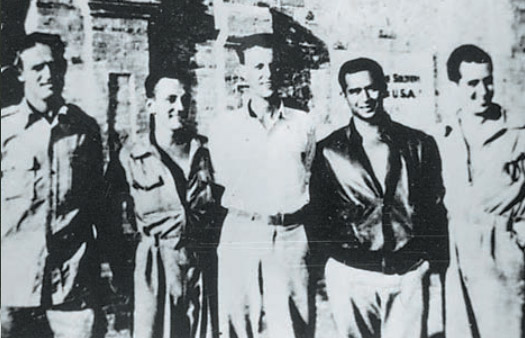 |
|
The rescued pilots in a more relaxed mood in 1944. [Provided to China Daily] |
For Chinese Vice-Premier Liu Yandong, who is in Washington for the seventh US-China Strategic and Economic Dialogue, her connection to the US-China wartime collaboration is deeply personal. During a diplomatic exchange in 2011, she presented Hillary Clinton, the US secretary of state, with a photograph of her father, Liu Ruilong, with a Flying Tiger pilot that he helped save.
As a young man fighting against the Japanese, Liu's father joined in a mission to rescue five US flyboys after their plane was shot down. Several soldiers died in the operation. "I still keep an old photo telling the story of my father, an anti-Japanese military leader, risking his life to rescue American pilots and sacrificing three of his own soldiers," Liu was quoted as saying.
Clinton, now a presidential hopeful, reportedly said she would hang the picture on the wall of her office as a reminder of the historical ties that bind the US and China.
Those ties began in earnest in early 1941, when retired US Army Air Corps officer Claire Lee Chennault brought 100 outdated Warhawks to China, along with 99 American pilots and ground crew who had all resigned commissions in the US military to join the fight.
Technically a mercenary outfit, but widely believed to be unofficially sanctioned by the US government before war was declared on Japan in December 1941, in the early days the American Volunteer Group presented China's only real air resistance to the Imperial Japan Army.
Using Chennault's unorthodox tactics, which involved attacking in pairs and making diving passes at the enemy, the squadron destroyed almost 300 Japanese aircraft, losing only 12 of their own. The Flying Tigers, as they came to be known, were formally absorbed into the US military in 1942 as the 14th Air Force under the command of Chennault.
According to Chinese historian Ge Shuya, by 1941, China's fledgling air force had been destroyed, while over the course of 199 days, Japan's 2,452 aircrafts bombed Kunming in Yunnan province 465 times. The Flying Tigers, which was expanded to about 3,000 planes, helped turn the tide.
They went on to destroy more than 2,500 enemy aircraft, sank or crippled 45 naval ships and 2.23 million metric tons worth of enemy merchant vessels, and killed more than 66,700 enemy troops.
Flying Tiger veteran David Hayward, 93, said it could not have been done without the assistance of the Chinese. The retiree, who lives in Los Angeles, flew 53 combat missions in a B-25 bomber between 1943 and 1944, and said the skies above wartime China were a dangerous place.
"The first three months we operated in China, 12 of our squadron of 16 airplanes were lost," he said. "They were lost either by Japanese attacks, or anti-aircraft fire from the ground, or simply crashing into a mountain. I had a lot of close calls."
The help from Chinese allies was vital, he said. "We had something called the Chinese net, an early warning system, maintained by the Chinese. They would warn us when enemy airplanes were approaching, so we could put our planes in the air.
"Some of the crews were able to bail out or make crash landings (after they were shot down). We had several cases in our squadron where men had to bail out of their airplane and were helped back to friendly lines by the Chinese. It was very reassuring."